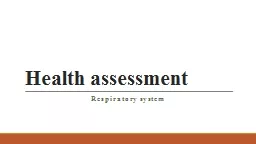

R espiratory system Introduction Respiratory system Exchange of gases in the body Intake of oxygen and release of carbon dioxide Central nervous system Functions Maintains acidbase balance ID: 510686
Download Presentation The PPT/PDF document "Health assessment" is the property of its rightful owner. Permission is granted to download and print the materials on this web site for personal, non-commercial use only, and to display it on your personal computer provided you do not modify the materials and that you retain all copyright notices contained in the materials. By downloading content from our website, you accept the terms of this agreement.
Slide1
Health assessment
R
espiratory
systemSlide2
Introduction
Respiratory system
Exchange of gases in the body
Intake of oxygen and release of carbon dioxide
Central nervous system
Functions
Maintains acid–base balance
Maintains body fluids
Assists with speechSlide3
Anatomy and Physiology Review
Upper respiratory tract
Nose, mouth, sinuses, pharynx, larynx, proximal trachea
Lower respiratory tract
Distal trachea, bronchi, lungs, pleural membranes, muscles of respiration, mediastinum
Respiratory cycleSlide4
Anatomy of the respiratory system.Slide5
Anatomy and Physiology Review
Thorax
Closed cavity containing the structures needed for respiration
Mediastinum
Heart
Trachea
Esophagus
Major blood vessels
Pleural cavities
continued on next slideSlide6
Anatomy and Physiology Review
Thorax
Thoracic cage
Bones
Cartilage
Muscles of the thoraxSlide7
Lower Respiratory Tract
Trachea
16–20 rings of hyaline cartilage
Bronchi
Main bronchus enters each lung at the
hilus
.
Terminal bronchioles less than 0.5 mm in diameterSlide8
Lower Respiratory Tract
Lungs
Cone-shaped, elastic, spongy, air-filled structures in pleural cavities
Right lung has three lobes, left lung has two.Slide9
Lower Respiratory Tract
Pleural membranes
Thin, double-layered serous lining
Surface tension created by fluid and negative pressure between membranes keeps lungs expanded.
Mediastinum
Middle section of thoracic cavity
Surrounded by right and left pleural cavitiesSlide10
Landmarks
Bony structures
Sternum
Angle of Louis
Clavicles
Ribs
Vertebral column Slide11
Landmarks
Horizontal and vertical lines
Anterior, posterior, and lateral sections
Division of the thorax
Anterior
Imaginary vertical lines
Sternal
Midclavicular
Anterior axillary linesSlide12
Landmarks
Division of the thorax
Posterior
Imaginary vertical lines
Vertebral
Scapular
Posterior axillary
continued on next slideSlide13
Landmarks
Division of the thorax
Lateral
Imaginary vertical lines
Anterior
Posterior
Midaxillary
Slide14
Lines of the anterior thorax.Slide15
Lines of the posterior thorax.Slide16
Lines of the lateral thorax.Slide17
Lobes of the lungs: Posterior view.Slide18
Lobes of the lungs: Anterior view.Slide19
Lateral view of lobes of the left lung.
continued on next slideSlide20
Lateral view of lobes of the right lung.Slide21
Special Considerations
Age
Developmental level
Race
Ethnicity
Work history
Living conditions
Socioeconomic status
Emotional wellnessSlide22
Lifespan Considerations
Infants and children
Change from intrauterine to
extrauterine
breathing
Use of abdominal muscles for breathing during infancy and early childhood
Costal breathing expected after age 7
Smaller airways more prone to blockage
continued on next slideSlide23
Lifespan Considerations
The pregnant female
Muscles and cartilage of the ribs relax.
Inspiratory capacity increases.
Expiratory reserve volume is decreased.
Total lung capacity remains the same.
Oxygen consumption can increase by 20%
Mild respiratory alkalosisSlide24
Lifespan Considerations
The older adult
Decrease in respiratory efficiency
Changes in respiratory depth
Decrease in cough ability
Increase in respiratory rate
Anxiety and physical exertion can cause significant demands.
Increased effect of infectionSlide25
Psychosocial Considerations
Exacerbation of respiratory problems
Stress
Anxiety
Fatigue
Pain
Certain drugs used in the treatment of respiratory disorders may cause hands to tremble.Slide26
Cultural and Environmental Considerations
Race
Ethnicity
Presence of allergens
Socioeconomic status
Incidence of respiratory diseases
Geography and environment
Temperature, moisture, altitude, and pollutionSlide27
Focused Interview
Consider patient's ability to participate
If patient is experiencing dyspnea, cyanosis, difficulty with speech, or anxiety, attention must focus on relief of symptoms and restoration of oxygenation.Slide28
Focused Interview
Focused interview questions
General
Illness or infection
Symptoms, pain, behaviors
Age
Infants and children
The pregnant female
The older adult
EnvironmentSlide29
Assessment Techniques
Inspection
Palpation
Percussion
AuscultationSlide30
Assessment Techniques
Observation of skin color
Inspection of the anterior and posterior thorax
Symmetry
Configuration
Respiratory rateSlide31
Assessment Techniques
Palpation of the posterior thorax
Ribs
Intercostal spaces
Respiratory expansion
Tactile fremitus Slide32
Patient positioned and gowned for assessment.Slide33
Pattern for palpating the posterior thorax.Slide34
Palpation for respiratory expansion.Slide35
Palpation for tactile fremitus using metacarpophalangeal joint area.Slide36
Assessment Techniques
Percussion of the posterior thorax
Lungs
Diaphragmatic excursionSlide37
Pattern for percussion: Posterior thorax.Slide38
Diaphragmatic movement, percussion.
continued on next slideSlide39
Diaphragmatic movement, measurement.Slide40
Assessment Techniques
Auscultation of the posterior thorax for sounds
Tracheal
Bronchial
Bronchovesicular
VesicularSlide41
Pattern for auscultation: Posterior thorax.Slide42
Normal Breath SoundsSlide43
Adventitious Breath SoundsSlide44
Assessment Techniques
Auscultation of voice sounds
Bronchophony
Egophony
Whispered
pectoriloquy
Palpation of the anterior thorax Slide45
Assessment Techniques
Palpation of the anterior thorax
Sternum
Ribs
Intercostal spacesSlide46
Palpation of the anterior thorax.Slide47
Palpation for respiratory expansion: Anterior view.Slide48
Palpation for tactile fremitus: Anterior thorax.Slide49
Pattern for percussion: Anterior thorax.
continued on next slideSlide50
Pattern for percussion: Left lateral thorax.Slide51
Auscultatory sounds: Anterior thorax.Slide52
Normal and Abnormal Respiratory Rates and Patterns
continued on next slideSlide53
(continued)
Normal and Abnormal Respiratory Rates and Patterns
continued on next slideSlide54
(continued)
Normal and Abnormal Respiratory Rates and PatternsSlide55
Normal Chest Configurations
continued on next slideSlide56
(continued) Normal Chest Configurations
continued on next slideSlide57
(continued) Normal Chest ConfigurationsSlide58
Abnormal Chest Configurations
continued on next slideSlide59
(continued) Abnormal Chest Configurations
continued on next slideSlide60
(continued) Abnormal Chest Configurations
continued on next slideSlide61
(continued) Abnormal Chest ConfigurationsSlide62
Abnormal Findings
Respiratory disorders
Asthma
Chronic
hyperreactive
condition
Atelectasis
Obstruction of airflow
Bronchitis
Inflammation of the tracheobronchial treeSlide63
Asthma.Slide64
Atelectasis.Slide65
Chronic bronchitis.Slide66
Abnormal Findings
Respiratory disorders
Emphysema (obstruction of the alveoli)
Pneumonia (infection if the alveoli)
Pleural effusion (fluid in the pleural space)Slide67
Emphysema.Slide68
Lobar pneumonia.Slide69
Pleural effusion.Slide70
Abnormal Findings
Respiratory disorders
Pneumothorax (collapse of the lung)
Congestive heart failure (edema around the alveoli)
Valley feverSlide71
Pneumothorax.Slide72
Left heart failure.